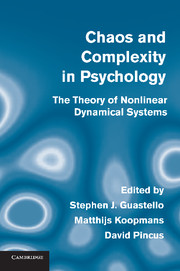Book contents
- Frontmatter
- Contents
- Contributors
- Preface
- 1 Introduction to Nonlinear Dynamics and Complexity
- 2 Collective Intelligence: Observations and Models
- 3 Neurodynamics and Electrocortical Activity
- 4 Psychophysics
- 5 Temporal and Spatial Patterns in Perceptual Behavior: Implications for Dynamical Structure
- 6 Embodied and Embedded: The Dynamics of Extracting Perceptual Visual Invariants
- 7 Origins of Order in Cognitive Activity
- 8 Nonlinear Complex Dynamical Systems in Developmental Psychology
- 9 Developmental Psychopathology: Maladaptive and Adaptive Attractors in Children's Close Relationships
- 10 Psychopathology
- 11 Coherence, Complexity, and Information Flow: Self-Organizing Processes in Psychotherapy
- 12 The Dynamics of Human Experience: Fundamentals of Dynamical Social Psychology
- 13 Group Dynamics: Adaptation, Coordination, and the Emergence of Leaders
- 14 Organizational Psychology
- 15 Complexity, Evolution, and Organizational Behavior
- 16 Agent-Based Modeling Within a Dynamic Network
- 17 Epilogue: Psychology at the Edge of Chaos
- Index
7 - Origins of Order in Cognitive Activity
Published online by Cambridge University Press: 18 December 2013
- Frontmatter
- Contents
- Contributors
- Preface
- 1 Introduction to Nonlinear Dynamics and Complexity
- 2 Collective Intelligence: Observations and Models
- 3 Neurodynamics and Electrocortical Activity
- 4 Psychophysics
- 5 Temporal and Spatial Patterns in Perceptual Behavior: Implications for Dynamical Structure
- 6 Embodied and Embedded: The Dynamics of Extracting Perceptual Visual Invariants
- 7 Origins of Order in Cognitive Activity
- 8 Nonlinear Complex Dynamical Systems in Developmental Psychology
- 9 Developmental Psychopathology: Maladaptive and Adaptive Attractors in Children's Close Relationships
- 10 Psychopathology
- 11 Coherence, Complexity, and Information Flow: Self-Organizing Processes in Psychotherapy
- 12 The Dynamics of Human Experience: Fundamentals of Dynamical Social Psychology
- 13 Group Dynamics: Adaptation, Coordination, and the Emergence of Leaders
- 14 Organizational Psychology
- 15 Complexity, Evolution, and Organizational Behavior
- 16 Agent-Based Modeling Within a Dynamic Network
- 17 Epilogue: Psychology at the Edge of Chaos
- Index
Summary
Origins of Order in Cognitive Activity
Most cognitive scientists have run across The War of the Ghosts, a Native American story used by Bartlett (1932) in his classic studies of remembering. British college students read the story twice and recalled it in detail after 15 minutes, hours, days, months, or years “as opportunity offered” (p. 65). The compelling finding was that participants reinterpreted parts of the story, in addition to omitting details. The mystical story was reorganized and changed in the retelling to fit cultural norms of the British participants. In other words, errors in retelling the story were neither random nor arbitrary but fit together within a larger created narrative. The memory errors illustrate the ordinary constructive performance of cognition and the creation of orderly and sensible thought. Despite perpetually moving eyes, swaying body, and ambiguous stimuli, people perceive coherent and orderly objects. Despite the lack of explicit links between events, higher-order cognition fits thought and behavior within larger coherent narratives. However, the origin of such order remains a mystery. What is the basis of orderly thought, memory, speech, and other cognitive abilities?
The origin of order in cognition is the topic of this chapter. We begin with a discussion of how order is explained within a traditional approach of information processing. Taking the shortcomings of this account seriously, we then turn to other disciplines – those that have framed the question of order more successfully.
- Type
- Chapter
- Information
- Chaos and Complexity in PsychologyThe Theory of Nonlinear Dynamical Systems, pp. 206 - 241Publisher: Cambridge University PressPrint publication year: 2008
- 4
- Cited by



